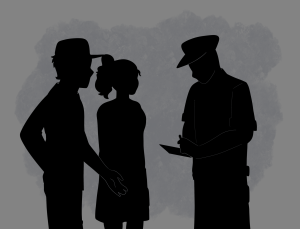Antigo Nick Contemporizes Greek Tragedy
November 12, 2016
The classic Greek tragedy of Antigone has been brought into contemporary times through Anne Carson’s unique and radical translation of the play, “Antigo Nick” (alternately spelled “Antigonick”). The play, directed by Professor Jessica Cerullo, was performed in Harper Joy Theater from Nov. 10 through Nov. 13. Whitman seniors Lauren Rekhelman and Roxanne Stathos have been working on the production since last spring as part of their senior project.
The play follows the Ancient Greek myth: Antigone, whose recently deceased brother, a traitor to the nation, has been barred from a proper burial courtesy of the new king, Kreon, resulting in a moral showdown between the two.
Although “Antigo Nick” is a translation of Sophocles’ original “Antigone” from Greek to English, there are marked differences between the two that elevate Carson’s translation. “Antigo Nick” is shorter than the original tragedy and contains references to philosophers and playwrights from long after Sophocles’ time.
“It’s still considered a translation because she’s taking the series of actions that make up the play, and she’s looking at what those are in the original, and then she’s translating them as they are, not necessarily by language but by meaning to us now,” Rekhelman, who portrayed Antigone and Teiresias, said.
Another major difference is that there is a character added in Carson’s version, called Nick. He is a silent presence who measures things throughout the play, such as distance between characters and words, and often represents Antigone’s traitorous deceased brother, Polynikes.
“Nick could really be anything, and in our production he represents a lot of different things,” Rekhelman said. “[T]he passage of time, the silent observer … the dead … in any given production I think Nick would be something different.”
This production used a dance-theater approach. Choreographed by Professor Renée Archibald of the Theater Department and Heather Hamilton, a Whitman student, the deliberate dance-like movements are especially prominent in the character of Nick.
“It brings it into the realm of physical theater,” Rekhelman said. “I think that making a classical drama that has an Aristotelian structure and bringing in this very contemporary idea of movement-based theater and physical theater, it definitely adds a layer to it and definitely makes it a living, breathing contemporary piece of theater.”
The production was remarkably relevant to the present time.
“We have had a lot of fun working with the script and considering our own world,” Cerullo wrote in an email to The Wire.
Cerullo included an audience conversation as an Act Two to the show as a space to discuss how the themes and issues presented in “Antigo Nick” are very present in our lives and own worlds today.
After the performance, Cerullo spoke about how the themes and issues presented in “Antigo Nick” are very present in our lives and own worlds today.
“There’s this whole idea of individuality versus the state, family versus law … I think it’s a conflict that we see throughout history,” Rekhelman said. “I think it’s also very relevant in terms of social and racial justice right now, because there’s this whole idea that [Polynikes] is, because of his actions, unmournable. We see this in terms of the Black Lives Matter movement right now, and these questions of whose lives matter and whose lives are mournable, and the idea of Michael Brown’s body being left out on the street for hours and the grief and outrage around that type of disrespect for human life.”
Issues such as this were discussed after the play, in an “Act Two” session where audience members could talk to cast members about the various themes found such as silence, mourning, and loyalty to the family and the state.
Overall, this unique take on “Antigone” was well done in this production. Stage Manager Teal Kurnie reflected on it.
“It’s definitely a different style of play than you think of when you think of going to the theater,” Kurnie said. “It’s a beautiful piece of art … it’s really just emotional ride but … you don’t laugh, cry, explode in emotion during the thing, but you just feel so much while you’re watching the performance.”






